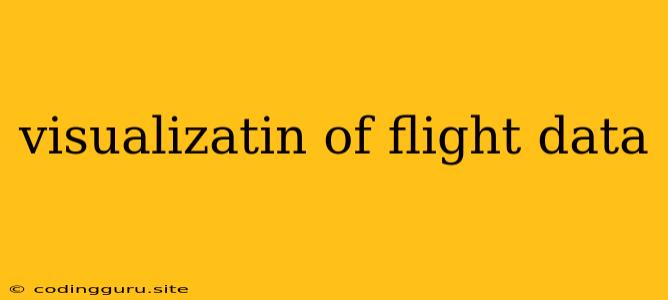Visualizing the Skies: A Deep Dive into Flight Data Visualization
The world of aviation is filled with fascinating data points, offering a window into the complex choreography of air travel. From flight paths and altitudes to aircraft types and delays, this data holds immense potential for understanding and optimizing the air travel ecosystem. But how do we make sense of this wealth of information? Enter flight data visualization, a powerful tool that transforms raw data into insightful, interactive, and easily digestible visuals.
Why Visualize Flight Data?
Imagine a world without maps – it would be impossible to navigate effectively. Flight data visualization serves the same purpose, offering a clear visual representation of complex aviation information. Here are some key reasons why flight data visualization is crucial:
- Understanding Trends: By visualizing data over time, we can identify patterns and trends in flight operations. Are certain routes experiencing increased delays? Are particular aircraft types more prone to technical issues? Visualizations can highlight these trends, allowing for proactive measures to be taken.
- Optimizing Efficiency: Data visualizations can help airlines optimize their operations by identifying areas for improvement. For instance, visualizing flight paths can reveal opportunities to shorten routes, reduce fuel consumption, and minimize delays.
- Enhancing Safety: By visualizing safety data, we can identify potential hazards and areas for improvement in safety protocols. Real-time visualizations can also track aircraft movements, allowing for faster response in emergency situations.
- Facilitating Decision-Making: Visualizations provide a clear and concise overview of complex data, enabling stakeholders to make informed decisions. This can range from route planning and scheduling to resource allocation and strategic planning.
- Engaging the Public: Visualizations make complex data accessible and understandable for a broader audience. Interactive maps and charts can engage the public, fostering greater awareness and understanding of the aviation industry.
Types of Flight Data Visualizations
The possibilities for flight data visualization are vast and varied, encompassing various types of visualizations that cater to different needs and objectives. Here are some common types:
1. Flight Path Maps: These maps display flight paths, showcasing the movement of aircraft across geographical regions. Colors and thickness can represent factors such as altitude, speed, and time.
2. Heatmaps: Heatmaps use color gradients to represent the density of flights in specific areas. This can help identify popular routes, busy airspace, and potential areas of congestion.
3. Scatter Plots: Scatter plots can be used to visualize relationships between variables, such as aircraft type and flight duration, or altitude and fuel consumption.
4. Bar Charts: Bar charts effectively represent categorical data, such as the number of flights by airline, delay frequency, or aircraft type.
5. Line Graphs: Line graphs are ideal for visualizing trends over time, such as the number of flights, delays, or fuel prices.
6. Interactive Dashboards: These dashboards combine multiple visualization types into a single interface, providing a comprehensive overview of flight data and allowing users to interact and filter data.
Tools for Flight Data Visualization
A wide range of tools are available for flight data visualization, each with its own strengths and limitations. Some popular choices include:
- Data Visualization Libraries: Python libraries like Matplotlib, Seaborn, and Plotly offer extensive capabilities for creating custom visualizations.
- Mapping Libraries: Libraries like Leaflet and Google Maps API enable interactive map-based visualizations.
- Business Intelligence Tools: Platforms like Tableau and Power BI provide drag-and-drop interfaces for creating sophisticated visualizations.
- Open Data Platforms: Platforms like FlightAware and Flightradar24 offer real-time flight tracking data and visualization tools.
Examples of Flight Data Visualization
Let's delve into some real-world examples of how flight data visualization is being used:
- Air Traffic Control: Air traffic control systems use visualization tools to monitor aircraft movements in real-time, ensuring safe and efficient air traffic management.
- Airline Operations: Airlines utilize data visualization to analyze flight performance, identify delays, optimize routes, and improve operational efficiency.
- Airport Management: Airports rely on data visualization to analyze passenger flow, optimize terminal layout, and improve airport operations.
- Research and Analysis: Aviation researchers utilize visualization tools to analyze flight data, study trends, and gain insights into aviation safety, efficiency, and environmental impact.
Tips for Effective Flight Data Visualization
Creating effective flight data visualization requires careful consideration of the data, target audience, and intended purpose. Here are some key tips:
- Choose the Right Visualization: Select visualization types that best suit the data and the message you want to convey.
- Keep it Simple: Avoid overly complex visualizations that can overwhelm the audience.
- Use Color Effectively: Choose colors that are visually appealing and convey meaning effectively.
- Label Axes and Data Points: Ensure clarity and understanding by labeling axes and data points clearly.
- Provide Context: Include relevant information, such as time periods, locations, and data sources, to provide context for the visualization.
- Enable Interactivity: Allow users to interact with the visualizations, filtering, zooming, and exploring the data.
Conclusion
Flight data visualization is an essential tool for understanding, analyzing, and optimizing the aviation industry. By transforming raw data into insightful visuals, we can gain valuable insights, make informed decisions, and contribute to the safety, efficiency, and sustainability of air travel. As technology advances and data availability increases, we can expect even more innovative and impactful applications of flight data visualization in the years to come.
